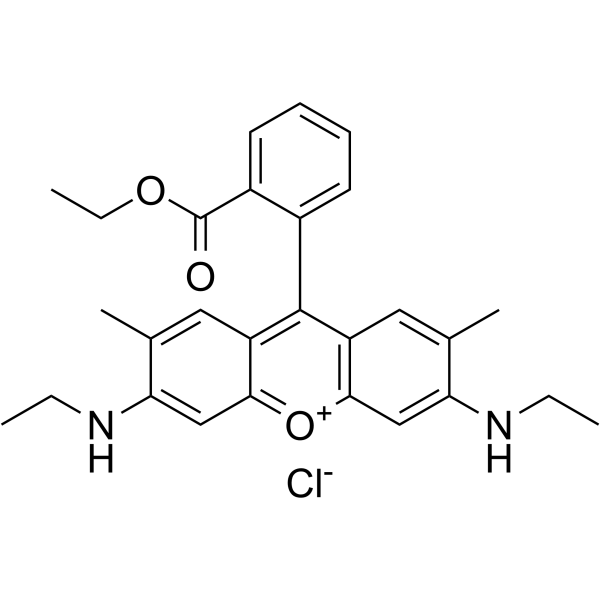Rhodamine 6G;(Synonyms: 罗丹明6G; Basic Red 1) 纯度: ge;98.0%
Rhodamine 6G是罗丹明类似物,可用于Pgp外排测定试验中。它可用于MRP1-介导外排的动力学试验中,以及作为激光染料和具有线粒体探针的潜力。

Rhodamine 6G Chemical Structure
CAS No. : 989-38-8
| 规格 | 价格 | 是否有货 | 数量 |
|---|---|---|---|
| Free Sample (0.1-0.5 mg) | ; | Apply now | ; |
| 10;mM;*;1 mL in DMSO | ¥550 | In-stock | |
| 250 mg | ¥500 | In-stock | |
| 1 g | ¥800 | In-stock | |
| 5 g | ¥1200 | In-stock | |
| 10 g | ; | 询价 | ; |
| 50 g | ; | 询价 | ; |
* Please select Quantity before adding items.
Rhodamine 6G 相关产品
bull;相关化合物库:
- FDA Approved amp; Pharmacopeial Drug Library
- Clinical Compound Library Plus
- Bioactive Compound Library Plus
- Anti-Cancer Compound Library
- Clinical Compound Library
| 生物活性 |
Rhodamine 6G is a rhodamine analog useful in Pgp efflux assays. It can be used in characterizing the kinetics of MRP1- mediated efflux, and as a laser dye and potential mitochondrial probe. |
||||||||||||||||
|---|---|---|---|---|---|---|---|---|---|---|---|---|---|---|---|---|---|
| 体外研究 (In Vitro) |
Rhodamine 6G, also known as Rhodamine 590, is widely used as a lasing medium and as a fluorescence tracer. For use in dye lasers, it is dissolved in methanol, ethanol and a variety of other organic solvents. In environmental flow studies, the tracer medium is typically water. In ethanol, the absorption of rhodamine 6G ranges between 440 nm and 570 nm, with the peak at 530 nm. It is thus ideally suited for pumping by frequency doubled Nd:YAG lasers at 532 nm, copper vapor lasers at 511 nm, and argon-ion lasers at 514 nm. The resulting emission spectrum varies from about 510 nm to around 710 nm with the peak at 550 nm depending on the solvent and the dye concentration. However, the laser emission range is much narrower, from around 560 nm to 610 nm with the peak wavelength around 575 nm. Energy conversion efficiencies greater than 50% are achievable. In order to select the optimal solvent and dye concentration, good knowledge of their effects is a pre-requisite. Rhodamine 6G in DMSO shows a distinct behavior exhibiting only 41% of the fluorescence intensity of the methanol case with an 11 nm red-shifted wavelength. Relatively small changes of the fluorescence spectrum are observed for the different solvents; the highest fluorescence intensity is observed for methanol and lowest for DMSO. The shortest peak wavelength is found in methanol (568 nm) and the longest in DMSO (579 nm). Changing the dye concentration provides tunability between 550 nm in the dilute case and 620 nm at high concentration, at which point the fluorescence spectrum indicates the formation of rhodamine 6G aggregates[1]. Rhodamine 6G is a fluorescent dye capable of penetrating a living cell. Upon entering the cell, Rhodamine 6G binds to the inner membranes of mitochondria. Based on these observations, it has been proposed that Rhodamine dyes may be used for producing fluorescent images of mitochondria with low background noise and high resolution. Extremely low concentrations of Rhodamine 6G appear to selectively destroy malignant cells in culture, sparing the normal cell populations[2]. MCE has not independently confirmed the accuracy of these methods. They are for reference only. |
||||||||||||||||
| 体内研究 (In Vivo) |
Melanoma-transplanted mice receiving Rhodamine 6G demonstrate prolonged survival, improved clinical parameters, inhibited tumor growth and metastases count, compared to their untreated counterparts. Twice-a-week 10-6M Rhodamine 6G regimen yield the most prominent results[2]. The Rhodamine-6G enters the circulatory system and labels leukocytes. It is possible to monitor changes in the interactions between leukocytes and the endothelium by determining the numbers of rolling and adhering leukocytes as well as the total flux of these cells[3]. MCE has not independently confirmed the accuracy of these methods. They are for reference only. |
||||||||||||||||
| Clinical Trial |
|
||||||||||||||||
| 分子量 |
479.01 |
||||||||||||||||
| Formula |
C28H31ClN2O3 |
||||||||||||||||
| CAS 号 |
989-38-8 |
||||||||||||||||
| 中文名称 |
罗丹明6G |
||||||||||||||||
| 运输条件 |
Room temperature in continental US; may vary elsewhere. |
||||||||||||||||
| 储存方式 |
4deg;C, sealed storage, away from moisture and light *In solvent : -80deg;C, 6 months; -20deg;C, 1 month (sealed storage, away from moisture and light) |
||||||||||||||||
| 溶解性数据 |
In Vitro:;
DMSO : 25 mg/mL (52.19 mM; Need ultrasonic) H2O : 10 mg/mL (20.88 mM; ultrasonic and warming and heat to 60°C) 配制储备液
*
请根据产品在不同溶剂中的溶解度选择合适的溶剂配制储备液;一旦配成溶液,请分装保存,避免反复冻融造成的产品失效。 In Vivo:
请根据您的实验动物和给药方式选择适当的溶解方案。以下溶解方案都请先按照 In Vitro 方式配制澄清的储备液,再依次添加助溶剂: ——为保证实验结果的可靠性,澄清的储备液可以根据储存条件,适当保存;体内实验的工作液,建议您现用现配,当天使用; 以下溶剂前显示的百
|
||||||||||||||||
| 参考文献 |
|
| Cell Assay [2] |
Malignant cells and normal control cultures are seeded in equal (protein adjusted) cell amounts into 6-well tissue culture plates. The cells are pulsed with 25µCi/mL of 3H-Thymidine and immediately treated with Rhodamine 6G at the fixed concentration of 1 μM for 24h, 48h, 72h or 5 days (120h). Following 24h, 48h, 72h or 5 days, the excessive radioactive material is ished out with PBS. The cell samples are transferred into polystyrene vials containing 4 ml scintillation liquid, and their radioactivity counted in a β-counter. Total cell protein is assessed by Bradford’s assay[2]. MCE has not independently confirmed the accuracy of these methods. They are for reference only. |
|---|---|
| Animal Administration [2] |
Mice: C57Bl mice are implanted with B16-F10 melanoma and treated with Rhodamine 6G (1, 0.1, 0.01 μM) at different dosage/time regimens. Viability and proliferation of cultured tumor cells are analyzed[2]. MCE has not independently confirmed the accuracy of these methods. They are for reference only. |
| 参考文献 |
|
